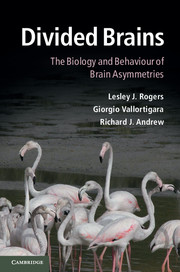5 - Causation
Published online by Cambridge University Press: 05 February 2013
Summary
Summary
Left–right differences are too complex to be summarized by any simple dichotomy. In particular, interaction between the left and right hemispheres is crucial, with shifts in control reflecting collaboration, as well as bringing to bear the specializations of one rather than the other side. A major theme of this chapter is an attempt to show how specializations of one or other hemisphere interact with those of its partner. It has been argued that left hemisphere control is needed for assessment of a stimulus (e.g. assignment to a category) and for the subsequent selection of an appropriate response. However, initial detection of a stimulus is often made by the right hemisphere, owing to its ability to attend widely across panoramic space and to a wide range of properties of the stimulus. The left hemisphere may then intervene to control further assessment. At the same time, when a task is being performed, the left hemisphere is able to specify relevant properties of the stimulus, which are then used in searching for that stimulus using both the right and left hemispheres.
Introduction
Discussions of brain lateralization, understandably, often attempt to make simple summaries of its organization. We might say that we talk with the ‘left brain’ and are emotional with the ‘right brain’. The term ‘brain’ itself is inadequate here, as we will see when considering the roles of different structures; the term ‘hemisphere’ (i.e. cerebral hemisphere) is used when it is reasonably clear that forebrain structures are chiefly involved. Such terms are a necessary convenience for broad generalizations. Nevertheless, it is clear that, although shortened characterizations of right and left are unavoidable, at some points in discussions they should be treated with caution. An unexpected recent attempt at such characterization (Dien, 2008) is that the left hemisphere ‘anticipates multiple possible futures’, while the right hemisphere ‘integrates ongoing strands of information into a single view of the past’. Novel dichotomies such as this, however, have the merit of provoking new lines of thought.
- Type
- Chapter
- Information
- Divided BrainsThe Biology and Behaviour of Brain Asymmetries, pp. 123 - 152Publisher: Cambridge University PressPrint publication year: 2013



